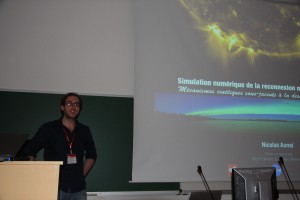Comparison between hybrid and fully kinetic models of asymmetric magnetic reconnection: Coplanar and guide field configurations
ADS Link, DOI
Aunai, Nicolas, Hesse, Michael, Zenitani, Seiji,
Kuznetsova, Maria, Black, Carrie, Evans, Rebekah and Smets, Roch
Magnetic reconnection occurring in collisionless environments is a multi-scale process involving both ion and electron kinetic processes. Because of their small mass, the electron scales are difficult to resolve in numerical and satellite data, it is therefore critical to know whether the overall evolution of the reconnection process is influenced by the kinetic nature of the electrons, or is unchanged when assuming a simpler, fluid, electron model. This paper investigates this issue in the general context of an asymmetric current sheet, where both the magnetic field amplitude and the density vary through the discontinuity. A comparison is made between fully kinetic and hybrid kinetic simulations of magnetic reconnection in coplanar and guide field systems. The models share the initial condition but differ in their electron modeling. It is found that the overall evolution of the system, including the reconnection rate, is very similar between both models. The best agreement is found in the guide field system, which confines particle better than the coplanar one, where the locality of the moments is violated by the electron bounce motion. It is also shown that, contrary to the common understanding, reconnection is much faster in the guide field system than in the coplanar one. Both models show this tendency, indicating that the phenomenon is driven by ion kinetic effects and not electron ones.


